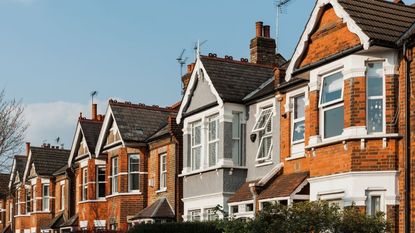Halifax: House prices rise for the third month in a row
Despite higher interest rates, Halifax says house prices are still rising in some parts of the country


Average house prices increased by 0.8% in March according to Halifax’s latest House Price Index.
While house prices rose in all UK nations and regions last month, the annual rate of growth continued to slow in most areas, down to 1.6% from 2.1% for the three previous months.
According to the lender, the typical UK property now costs £287,880, compared to £285,660 in February.
Subscribe to MoneyWeek
Subscribe to MoneyWeek today and get your first six magazine issues absolutely FREE

Sign up to Money Morning
Don't miss the latest investment and personal finances news, market analysis, plus money-saving tips with our free twice-daily newsletter
Don't miss the latest investment and personal finances news, market analysis, plus money-saving tips with our free twice-daily newsletter
But for those looking to either sell or buy a house, the broad picture remains unclear.
Kim Kinnaird, director at Halifax Mortgages, notes while the market is still recovering from the mini-budget, the latest figures suggest some stability has returned to the housing market in the first few months of 2023.
“This has been characterised by a partial recovery in activity and transactions, especially when compared to the significant drops seen at the end of last year, with the latest Bank of England data showing mortgage approvals rising for the first time in six months,” she said.
“While rates remain much higher than the average of the last decade, across the industry a typical five-year fixed rate deal (75% LTV) is down by more than 100 basis points over the last few months,” Kinnaird added.
An expected fall in inflation over the coming months could further aid the recovery, but mortgage costs are unlikely to get “significantly cheaper in the short term” while the housing market will the new norms of higher borrowing costs and lower demand.
“Therefore, we still expect to see a continued slowdown through this year,” she said.
How have house prices changed per region?
The average house price edged up in all the UK nations and regions during March according to Halifax’s data, although growth slowed in most areas (with the exceptions of Greater London and the North East).
Northern Ireland continues to report the strongest annual growth in house prices of 4.9% (average house price of £186,459), followed by the West Midlands (3.8%, average property price of £248,308).
In Wales, the rate of annual property price inflation has slowed to 1.0% (average house price of £213,959).
Similarly in Scotland, the annual rate of growth fell to 2.3% (average property price of £199,853).
Average house prices in London are up very slightly on this time last year (0.1%) with the typical property now costing £537,250.
What will happen to house prices this year?
A separate analysis by Rightmove showed house prices rose 0.8% in March, largely on the back of a jump in the cost of large homes.
Meanwhile, Nationwide found house prices fell by 3.1% on a year-on-year basis in March, the largest annual decline since July 2009, triggering fears that the housing market will face a significant downturn for the remainder of the year.
These conflicting assessments are symptomatic of a “hiccupping market that is adjusting to a come down” from the rapid pace of house price growth over the past few years, said Myron Jobson, senior personal finance analyst at interactive investor.
"The reality is there is a collection of micro-markets at play. There are still regions where gazumping and bidding wars are rife, and the opposite is true in other parts of the nation. Estate agents have reported that a lack of supply in larger properties have kept prices inflated, as the race for space theme continues to play out,” he said.
A slump in mortgage rates, alongside a strong labour market, have helped to keep prices elevated, Jobson explained.
“But there is mounting evidence that the housing market is seemingly in a pendulum moment — swinging back in a buyer’s market direction,” he added.
Sarah Coles, head of personal finance at Hargreaves Lansdown also acknowledged the mixed picture being presented by housing data this year.
“As Zoopla highlighted earlier this week, demand is still down 43% in a year and sales have fallen 16%. Sellers are still having to cut prices by an average of 4% - or £14,000 - in order to sell, and the annual growth of asking prices continues to fall,” she said.
For many, affordability is being pushed “to the limits”, meaning we are likely to see weakness “persist” in the market. “We’re unlikely to have seen the last of the price falls,” she added.
And with the start of a new tax year, the drain on people’s buying power is “far from over,” said Alice Haine, personal finance analyst at Bestinvest.
“While the worst of the cost-of-living crisis appears to be behind us, the outlook for house prices is uncertain as households still have a number of personal finance challenges to contend with that may affect their buying power,” she said.
Tom is a journalist and writer with an interest in sustainability, economic policy and pensions, looking into how personal finances can be used to make a positive impact.
He graduated from Goldsmiths, University of London, with a BA in journalism before moving to a financial content agency.
His work has appeared in titles Investment Week and Money Marketing, as well as social media copy for Reuters and Bloomberg in addition to corporate content for financial giants including Mercer, State Street Global Advisors and the PLSA. He has also written for the Financial Times Group.
When not working out of the Future’s Cardiff office, Tom can be found exploring the hills and coasts of South Wales but is sometimes east of the border supporting Bristol Rovers.
-
-
 Investment trust discounts hit 2008 levels. Here’s how to profit
Investment trust discounts hit 2008 levels. Here’s how to profitInvestment trust discounts have risen to levels not seen since 2008, here are three trusts looking to buy to profit.
By Rupert Hargreaves Published
-
 A luxury stock to buy at a high street price
A luxury stock to buy at a high street priceInvestors wrongly consider Watches of Switzerland a high-street outlet.
By Dr Matthew Partridge Published
-
 Investing in wine: how Cru Wine is reaching new audiences
Investing in wine: how Cru Wine is reaching new audiencesTips Gregory Swartberg, founder of fine wine specialist Cru Wine, talks to Chris Carter about how to start a wine collection
By Chris Carter Published
-
 Small companies with big potential
Small companies with big potentialMichael Taylor of Shifting Shares reviews his 2023 picks and highlights more promising minnows.
By Michael Taylor Published
-
 The MoneyWeek portfolio of investment trusts – July 2023 update
The MoneyWeek portfolio of investment trusts – July 2023 updateTips A decade ago we set up the MoneyWeek portfolio of investment trusts. They remain a compelling long-term bet says Rupert Hargreaves
By Rupert Hargreaves Published
-
 Women lead the way with ethical investments
Women lead the way with ethical investmentsDemand for more ethical investments has soared – and women are more likely to opt for them. Annabelle Williams, personal finance specialist at Nutmeg, takes a look at why.
By Annabelle Williams Published
-
 BoE: Mortgage payments to rise by £220 a month for households
BoE: Mortgage payments to rise by £220 a month for householdsMillions of households can expect a mortgage spike of around £200 a month - and some may even reach a extra £1,000 a month, the Bank of England warns
By Marc Shoffman Published
-
 What happened to Thames Water?
What happened to Thames Water?Thames Water, the UK’s biggest water company could go under due to mismanagement and debt. We look into how the company got itself into this position, and what investors should expect.
By Simon Wilson Last updated
-
 Where to invest in the metals that will engineer the energy transition
Where to invest in the metals that will engineer the energy transitionA professional investor tells us where he’d put his money. This week: John Ciampaglia, manager of the Sprott Energy Transition Materials UCITS ETF.
By Nicole García Mérida Published
-
 How investors can profit from high food prices
How investors can profit from high food pricesThe latest furore over grocery prices will die down, says David Stevenson. But the long-term outlook for soft commodities remains bullish. These are the stocks investors can buy to profit from high food prices.
By David J Stevenson Published









